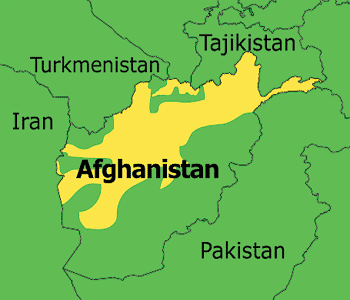By: UCLA Language Materials Project
 Number of Speakers: 7.6 million Number of Speakers: 7.6 million
Key Dialects: There are different dialects of Dari spoken in Afghanistan. People living close to the Iranian border speak in Persian, while those living in northern Afghanistan speak the Shamaly dialect. The principal dialects spoken in Afghanistan are Herati Dari, Tajiki Dari, Kabuli Dari, Khorasani Dari, and Parsiwan. In Iran, the key dialects are Yazd Dari and Kerman Dari.
Geographical Center: Afghanistan
GENERAL INTRODUCTION
Along with Pashto, Dari is one of the two official languages of Afghanistan. A member of the Northwestern Iranian language subfamily, Dari is closely related to languages such as Kurdish, Baluchi, and Gilaki. Dari is the Afghan dialect of Persian and as such is sometimes referred to as "Eastern Persian". Dari, rather than Pashto, serves as the lingua franca for the languages of Afghanistan. Roughly one-third of the population of Afghanistan (approximately five million) speak the language. Dari is also spoken by a total of two and a half million people in Iran, Pakistan, and neighboring regions. Iranian Dari, however, is considered to be endangered.
LINGUISTIC AFFILIATION
Dari is a Northwestern Iranian language of the Indo-Iranian subgroup of the Indo-European language family.
LANGUAGE VARIATION
Although phonological and lexical differences persist among the various dialects, they cause little difficulty in comprehension. These differences exist on a relatively small scale. This is valid even as regards the dialects spoken in Iran and Afghanistan. Most Afghani Dari dialects are more similar to literary Persian than the Iranian dialects. Zargari (Morghuli) is a secret language of artisans based on Persian.
ORTHOGRAPHY
Dari is written in a modified Arabic alphabet called Perso-Arabic, whose modifications are needed to account for Persian phonological differences.
LINGUISTIC SKETCH
Given that Dari is the Afghan dialect of Persian, it is not surprising that the two share a wealth of grammatical properties in common. It is also relatively unsurprising that Dari has imported a number of loan words from both Persian and Arabic. In fact, the vocabulary of Dari is closer to Tajiki than Persian. The syntax and morphology of Dari do not differ from Persian in any significant way. However, the bulk of the grammatical differences are phonological, perhaps due to the influence of neighboring Turkic languages. For instance, accent on stressed syllables is much less prominent in Dari than in Persian. The consonant and vowel systems of Dari differ from that of Persian as well. For example, Dari has two long vowels o and e, which Persian lacks. In addition, the use of the dipthongs ai and aw in Dari have no correspondents in Persian. In this respect, Dari maintains vowel distinctions that have been lost in modern Persian. The dialectal variation between Dari and Persian has been described as analogous to that between European French and Canadian French. Given the grammatical parallels between Persian and Dari, the reader is invited to read the linguistic sketch of Persian at http://www.lmp.ucla.edu/Profile.aspx?LangID=63&menu;=004 to learn more of the basic grammatical properties (syntactic and morphological) of Dari.
ROLE IN SOCIETY
Dari plays an important role in Afghan society. It is one of the national languages of the country and is used by roughly 50% of the population. In addition, it represents the primary means of communication between speakers of different languages in Afghanistan. Dari is currently taught in Afghani schools, heard on national radio, and has enjoyed a long and prestigious literary tradition. The current status of Dari in countries where it does not enjoy national status, on the other hand, is less stable. In Iran, for instance, Dari is neither written nor taught in schools and is considered an endangered language. Iranians are gradually giving up Dari to speak/learn Persian, the official language of Iran. The variety of Dari spoken in Pakistan, however, although marginalized, is a relatively stable institution.
HISTORY
Dari emerged as the language of the Persians and Zorastrian priests after the defeat of the Parthians by Cyrus in the middle of the sixth century B.C. Shortly thereafter, Dari was adopted as the spoken language of the Persian courts of the Sassanids. Following the Muslim conquest in the sixth century A.D., Arabic replaced Dari as the official language of the Persians. This lasted roughly two hundred years. During this period, Dari was not forgotten and little by little came to take on a new form, influenced considerably by Arabic and Parthian. Scholars consider this linguistic amalgamation to be the mother of both Dari and Persian.
REFERENCES
Gordon, Raymond G., Jr. (Editor). 2005. Ethnologue: Languages of the World, Fifteenth Edition. Dallas: SIL International.
Farhadi, Rawan A.G. 1975. The Spoken Dari of Afghanistan: A Grammar of Kaboli Dari (Persian) Compared to the Literary Language. Kabul: Peace Corps.
Latify, Hafiz A. 1980. Spoken Dari. Washington, D.C.: Foreign Service Institute.
Reza, Assadi. 1985. Afghan Persian (Dari): Materials Status Report. Available from Eric Document Reproduction Service, 7420 Fullerton Road, Suite 110, Springfield, Virginia 22153-2852, Phone: 800-443-3742.
 Related Links Related Links
 Iranian Languages Iranian Languages
 Persian Literature and Poetry Persian Literature and Poetry
 Front Page Front Page
|

